框架源碼系列六:Spring源碼學習之Spring IOC源碼學習
Spring 源碼學習過程:

一、搞明白IOC能做什麽,是怎麽做的
1. 搞明白IOC能做什麽?
IOC是用為用戶創建、管理實例對象的。用戶需要實例對象時只需要向IOC容器獲取就行了,不用自己去創建,從而達到與具體類解耦。
2. IOC是怎麽做到的,即它的實現步驟是怎麽樣的?

2.1 用戶配置bean定義
我們使用Spring IOC時有幾種方式來配置bean定義呢?
xml的方式:
<bean id="abean" class="com.study.spring.samples.ABean"> <constructor-argtype="String" value="abean01"></constructor-arg> <constructor-arg ref="cbean"></constructor-arg> </bean> <bean id="cbean" class="com.study.spring.samples.CBean"> <constructor-arg type="String" value="cbean01"></constructor-arg> </bean>
註解方式:
package com.study.spring.samples; import com.study.spring.context.config.annotation.Autowired; import com.study.spring.context.config.annotation.Component; import com.study.spring.context.config.annotation.Qualifier; import com.study.spring.context.config.annotation.Value; @Component(initMethodName= "init", destroyMethodName = "destroy") public class ABean { private String name; private CBean cb; @Autowired private DBean dbean; @Autowired public ABean(@Value("leesmall") String name, @Qualifier("cbean01") CBean cb) { super(); this.name = name; this.cb = cb; System.out.println("調用了含有CBean參數的構造方法"); } public ABean(String name, CCBean cb) { super(); this.name = name; this.cb = cb; System.out.println("調用了含有CCBean參數的構造方法"); } public ABean(CBean cb) { super(); this.cb = cb; } }
Java-based容器配置方式:
@Configuration public class AppConfig { @Bean public MyService myService() { return new MyServiceImpl(); } }
上面的AppConfig類等價於:
<beans>
<bean id="myService" class="com.acme.services.MyServiceImpl"/>
</beans>
想了解java容器配置的朋友請看這篇文章:
Spring Java-based容器配置
2.2 IOC容器加載bean定義
用戶以上面的三種方式配置bean定義以後,Spring IOC容器怎麽來加載用戶的bean定義呢,這就需要我們來告訴它了
xml的方式告訴Spring IOC容器怎麽加載bean定義:
//類路徑下加載xml配置文件創建bean定義 ApplicationContext context = new ClassPathXmlApplicationContext("application.xml"); //文件系統下加載xml配置文件創建bean定義 ApplicationContext context1 = new FileSystemXmlApplicationContext("e:/study/application.xml"); //通用的xml方式加載xml配置文件創建bean定義 ApplicationContext context3 = new GenericXmlApplicationContext("file:e:/study/application.xml");
註解方式告訴Spring IOC容器怎麽加載bean定義:
xml方式指定註解要掃描的基礎包:
<beans> <context:component-scan base-package="com.study" /> </beans>
註解方式指定註解要掃描的基礎包:
import org.springframework.context.annotation.Bean; import org.springframework.context.annotation.ComponentScan; import org.springframework.context.annotation.Configuration; @Configuration @ComponentScan(basePackages="com.study") public class AppConfig { @Bean public MyService myService() { return new MyServiceImpl(); } }
也可在代碼中通過API指定註解掃描的基礎包:
// 掃描註解的方式創建bean定義 ApplicationContext ctx= new AnnotationConfigApplicationContext(); ctx.scan("com.study"); ctx.refresh(); MyService myService = ctx.getBean(MyService.class);
Java-based容器配置告訴Spring IOC容器怎麽加載bean定義:
使用AnnotationConfigApplicationContext告訴Spring IOC容器怎麽加載bean定義配置
跟實例化一個ClassPathXmlApplicationContext時將Spring XML文件用作輸入相似,在實例化一個AnnotationConfigApplicationContext時能夠使用@Configuration類作為輸入。這就等等於Spring容器全然零XML配置:
public static void main(String[] args) { ApplicationContext ctx = new AnnotationConfigApplicationContext(AppConfig.class); MyService myService = ctx.getBean(MyService.class); myService.doStuff(); }
AnnotationConfigApplicationContext不局限於僅僅使用@Configuration類。不論什麽@Component或JSR-330註解的類都能夠作為AnnotationConfigApplicationContext構造器的輸入:
public static void main(String[] args) { ApplicationContext ctx = new AnnotationConfigApplicationContext(MyServiceImpl.class, Dependency1.class, Dependency2.class); MyService myService = ctx.getBean(MyService.class); myService.doStuff(); }
使用無參的構造器實例化AnnotationConfigApplicationContext,然後使用register()方法對容器進行配置。這樣的方式在以編程方式構造一個AnnotationConfigApplicationContext時非常實用:
public static void main(String[] args) { ApplicationContext ctx = new AnnotationConfigApplicationContext(); ctx.register(AppConfig.class, OtherConfig.class); ctx.register(AdditionalConfig.class); ctx.refresh(); MyService myService = ctx.getBean(MyService.class); myService.doStuff(); }
啟用scan(String…?)的組件掃描:
import org.springframework.context.annotation.Bean; import org.springframework.context.annotation.ComponentScan; import org.springframework.context.annotation.Configuration; @Configuration @ComponentScan(basePackages="com.study") public class AppConfig { @Bean public MyService myService() { return new MyServiceImpl(); } }
scan方法掃描:
public static void main(String[] args) { ApplicationContext ctx = new AnnotationConfigApplicationContext(); ctx.scan("com.study"); ctx.refresh(); MyService myService = ctx.getBean(MyService.class); }
二、搞明白Spring IOC的從整體到部分

IOC整體是由以上幾部分組成起來工作的
三、找到Spring IOC入口,先理清楚主幹流程,然後再去研究各個流程的細節
我們從上面的使用示例,很清楚地看到,我們使用Spring IOC,只需要使用Spring提供的ApplicationContext這個API。ApplicationContext就是IOC容器。ApplicationContext就是Spring IOC的入口,源碼的學習就從它開始!
1. ApplicationContext是什麽
首先來了解ApplicationContext都是什麽,即它都有哪些角色、責任。它通過繼承很多接口而有很多角色。
ApplicationContext繼承的接口(角色)如下:
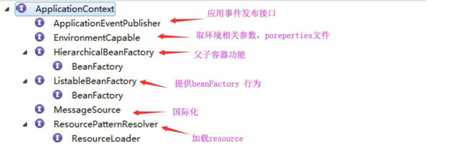
每個角色擁有的職責(方法):

再來了解 ApplicationContext 自己中定義的方法:

2. Application的子實現
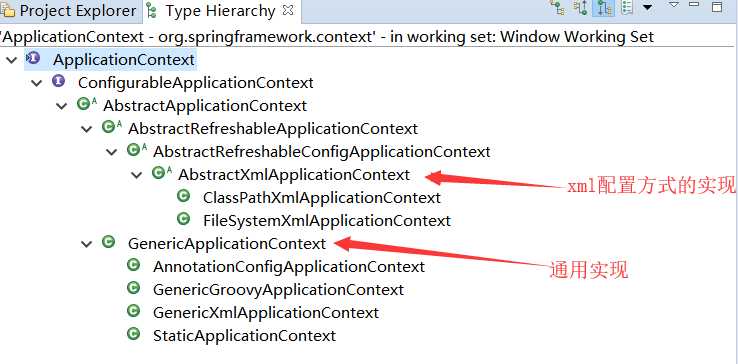
說明:
從 AbstarctApplicationContext 之後分為兩類:xml 配置方式的實現和通用實現。它們的基本使用示例如下:
package com.study.leesmall.spring; import org.springframework.beans.factory.xml.XmlBeanDefinitionReader; import org.springframework.context.ApplicationContext; import org.springframework.context.annotation.AnnotationConfigApplicationContext; import org.springframework.context.annotation.Bean; import org.springframework.context.annotation.ClassPathBeanDefinitionScanner; import org.springframework.context.annotation.Configuration; import org.springframework.context.support.ClassPathXmlApplicationContext; import org.springframework.context.support.FileSystemXmlApplicationContext; import org.springframework.context.support.GenericApplicationContext; import org.springframework.context.support.GenericXmlApplicationContext; import com.study.leesmall.spring.service.Abean; import com.study.leesmall.spring.service.CombatService; //Spring不同的方式創建bean實例使用代碼示例 @Configuration public class TestApplication { public static void main(String[] args) { //類路徑下加載xml配置文件創建bean定義 ApplicationContext context1 = new ClassPathXmlApplicationContext("application.xml"); CombatService cs = context1.getBean(CombatService.class); cs.doInit(); cs.combating(); //文件系統下加載xml配置文件創建bean定義 ApplicationContext context2 = new FileSystemXmlApplicationContext("e:/study/application.xml"); cs = context2.getBean(CombatService.class); cs.doInit(); cs.combating(); //通用的xml方式加載xml配置文件創建bean定義 ApplicationContext context3 = new GenericXmlApplicationContext("file:e:/study/application.xml"); cs = context3.getBean(CombatService.class); cs.doInit(); cs.combating(); // 掃描註解的方式創建bean定義 ApplicationContext context4 = new AnnotationConfigApplicationContext(TestApplication.class); CombatService cs2 = context4.getBean(CombatService.class); cs2.combating(); //通用的方式加載xml配置文件或者掃描指定包下的類創建bean定義 System.out.println("------------------------------------------------------"); GenericApplicationContext context5 = new GenericApplicationContext(); new XmlBeanDefinitionReader(context5).loadBeanDefinitions("classpath:application.xml"); new ClassPathBeanDefinitionScanner(context5).scan("com.study.leesmall.spring.service"); // 一定要刷新 context5.refresh(); cs2 = context5.getBean(CombatService.class); cs2.combating(); Abean ab = context5.getBean(Abean.class); ab.doSomething(); } @Bean public CombatService getCombatService() { return new CombatService(120); } }
接下來,可以打開每個子去了解它們分別加入了什麽、實現了什麽?
1)ConfigurableApplicationContext 加入了什麽:
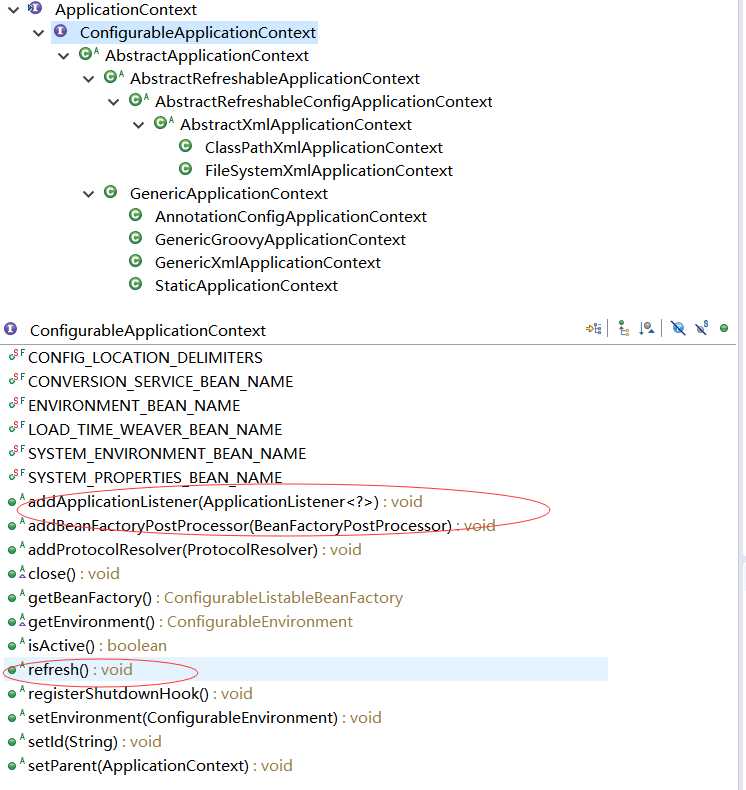
說明:
void addApplicationListener(ApplicationListener<?> listener):這個方法添加監聽 在這裏可以進行發布訂閱監聽的工作
void addBeanFactoryPostProcessor(BeanFactoryPostProcessor postProcessor):這個方法可以對bean工廠進行獲取前後的AOP增強
void refresh() throws BeansException, IllegalStateException:這個方法是用來刷新IOC容器的,當往IOC容器裏面註冊了新的Bean定義時,調用這個方法去創建bean實例
2)AbstractApplicationContext裏面對前面的接口就開始有具體的實現了,比如addApplicationListener、addBeanFactoryPostProcessor、refresh等等

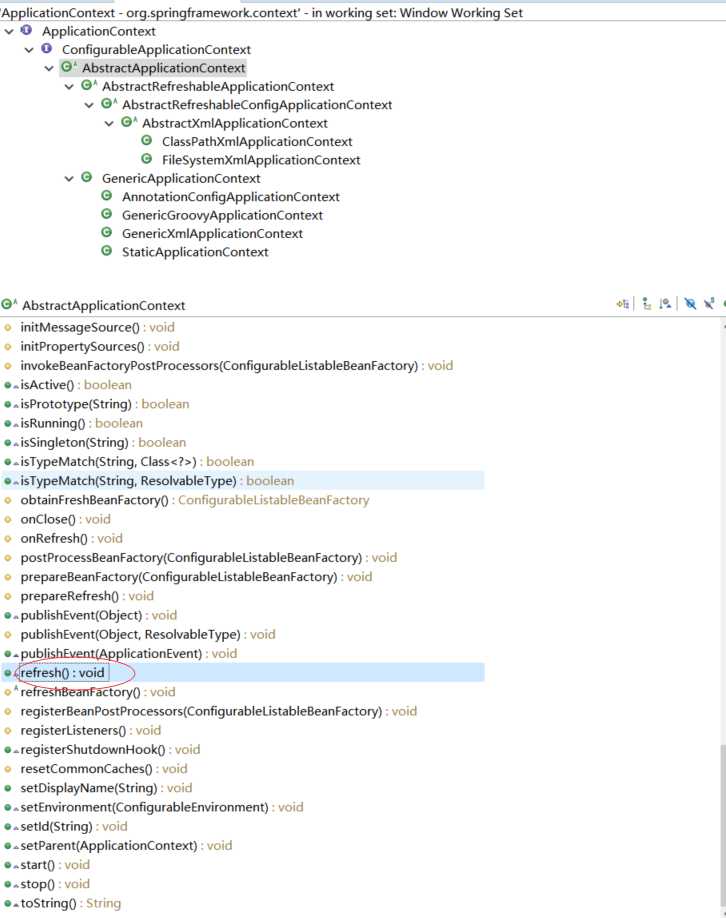
3)通用的實現GenericApplicationContext
public class GenericApplicationContext extends AbstractApplicationContext implements BeanDefinitionRegistry { private final DefaultListableBeanFactory beanFactory; @Nullable private ResourceLoader resourceLoader; private boolean customClassLoader = false; private final AtomicBoolean refreshed = new AtomicBoolean();
它實現了BeanDefinitionRegistry接口,該接口定義了bean定義信息的註冊行為。即我們可以直接往GenericApplicationContext中註冊bean定義。
了解一下BeanDefinitionRegistry中定義的行為:

都有誰實現了 BeanDefinitionRegistry 接口:

GenericApplicationContext中持有DefaultListableBeanFactory,GenericApplicationContext的bean定義註冊委托給了持有的DefaultListableBeanFactory

org.springframework.beans.factory.support.DefaultListableBeanFactory.registerBeanDefinition(String, BeanDefinition)對應代碼:

@Override public void registerBeanDefinition(String beanName, BeanDefinition beanDefinition) throws BeanDefinitionStoreException { Assert.hasText(beanName, "Bean name must not be empty"); Assert.notNull(beanDefinition, "BeanDefinition must not be null"); if (beanDefinition instanceof AbstractBeanDefinition) { try { ((AbstractBeanDefinition) beanDefinition).validate(); } catch (BeanDefinitionValidationException ex) { throw new BeanDefinitionStoreException(beanDefinition.getResourceDescription(), beanName, "Validation of bean definition failed", ex); } } BeanDefinition existingDefinition = this.beanDefinitionMap.get(beanName); if (existingDefinition != null) { if (!isAllowBeanDefinitionOverriding()) { throw new BeanDefinitionOverrideException(beanName, beanDefinition, existingDefinition); } else if (existingDefinition.getRole() < beanDefinition.getRole()) { // e.g. was ROLE_APPLICATION, now overriding with ROLE_SUPPORT or ROLE_INFRASTRUCTURE if (logger.isInfoEnabled()) { logger.info("Overriding user-defined bean definition for bean ‘" + beanName + "‘ with a framework-generated bean definition: replacing [" + existingDefinition + "] with [" + beanDefinition + "]"); } } else if (!beanDefinition.equals(existingDefinition)) { if (logger.isDebugEnabled()) { logger.debug("Overriding bean definition for bean ‘" + beanName + "‘ with a different definition: replacing [" + existingDefinition + "] with [" + beanDefinition + "]"); } } else { if (logger.isTraceEnabled()) { logger.trace("Overriding bean definition for bean ‘" + beanName + "‘ with an equivalent definition: replacing [" + existingDefinition + "] with [" + beanDefinition + "]"); } } this.beanDefinitionMap.put(beanName, beanDefinition); } else { if (hasBeanCreationStarted()) { // Cannot modify startup-time collection elements anymore (for stable iteration) synchronized (this.beanDefinitionMap) { this.beanDefinitionMap.put(beanName, beanDefinition); List<String> updatedDefinitions = new ArrayList<>(this.beanDefinitionNames.size() + 1); updatedDefinitions.addAll(this.beanDefinitionNames); updatedDefinitions.add(beanName); this.beanDefinitionNames = updatedDefinitions; if (this.manualSingletonNames.contains(beanName)) { Set<String> updatedSingletons = new LinkedHashSet<>(this.manualSingletonNames); updatedSingletons.remove(beanName); this.manualSingletonNames = updatedSingletons; } } } else { // Still in startup registration phase this.beanDefinitionMap.put(beanName, beanDefinition); this.beanDefinitionNames.add(beanName); this.manualSingletonNames.remove(beanName); } this.frozenBeanDefinitionNames = null; } if (existingDefinition != null || containsSingleton(beanName)) { resetBeanDefinition(beanName); } }View Code
接下來看GenericApplicationContext的兩個子AnnotationConfigApplicationContext和GenericXmlApplicationContext:
AnnotationConfigApplicationContext:
了解它的構造方法、register 方法

構造方法:
/** * Create a new AnnotationConfigApplicationContext that needs to be populated * through {@link #register} calls and then manually {@linkplain #refresh refreshed}. */ public AnnotationConfigApplicationContext() { this.reader = new AnnotatedBeanDefinitionReader(this); this.scanner = new ClassPathBeanDefinitionScanner(this); } /** * Create a new AnnotationConfigApplicationContext with the given DefaultListableBeanFactory. * @param beanFactory the DefaultListableBeanFactory instance to use for this context */ public AnnotationConfigApplicationContext(DefaultListableBeanFactory beanFactory) { super(beanFactory); this.reader = new AnnotatedBeanDefinitionReader(this); this.scanner = new ClassPathBeanDefinitionScanner(this); } /** * Create a new AnnotationConfigApplicationContext, deriving bean definitions * from the given annotated classes and automatically refreshing the context. * @param annotatedClasses one or more annotated classes, * e.g. {@link Configuration @Configuration} classes */ public AnnotationConfigApplicationContext(Class<?>... annotatedClasses) { this(); register(annotatedClasses); refresh(); } /** * Create a new AnnotationConfigApplicationContext, scanning for bean definitions * in the given packages and automatically refreshing the context. * @param basePackages the packages to check for annotated classes */ public AnnotationConfigApplicationContext(String... basePackages) { this(); scan(basePackages); refresh(); }
從構造函數可以看到要完成註解的掃描是通過註解bean定義讀取器AnnotatedBeanDefinitionReader和掃描器ClassPathBeanDefinitionScanner完成的
GenericXmlApplicationContext :
了解它的構造方法、load 方法
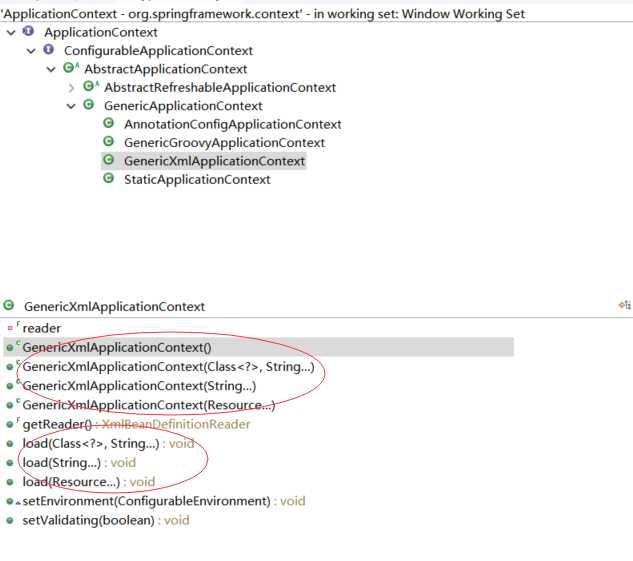
構造方法:
/** * Create a new GenericXmlApplicationContext that needs to be * {@link #load loaded} and then manually {@link #refresh refreshed}. */ public GenericXmlApplicationContext() { } /** * Create a new GenericXmlApplicationContext, loading bean definitions * from the given resources and automatically refreshing the context. * @param resources the resources to load from */ public GenericXmlApplicationContext(Resource... resources) { load(resources); refresh(); } /** * Create a new GenericXmlApplicationContext, loading bean definitions * from the given resource locations and automatically refreshing the context. * @param resourceLocations the resources to load from */ public GenericXmlApplicationContext(String... resourceLocations) { load(resourceLocations); refresh(); } /** * Create a new GenericXmlApplicationContext, loading bean definitions * from the given resource locations and automatically refreshing the context. * @param relativeClass class whose package will be used as a prefix when * loading each specified resource name * @param resourceNames relatively-qualified names of resources to load */ public GenericXmlApplicationContext(Class<?> relativeClass, String... resourceNames) { load(relativeClass, resourceNames); refresh(); }
從構造函數可以看出GenericXmlApplicationContext 能從不同的輸入中加載bean定義
四、細節分析
從前面的分析,已經對Spring IOC的整體由哪些部分組成有一個了解了,下面就深入去分析各個部分是怎麽實現的
1. Bean定義加載和解析
ApplicationContext如何加載、解析Bean定義的。讀源碼,我們不光是了解一下這個過程,更重要的是看它是如何設計接口、類來配合解決這個問題的,以及有哪些擴展點、靈活之處。
1.1 xml文件的bean配置的加載和解析
xml配置方式的bean定義獲取過程:

首先,你自己一定要思考清楚這個。然後才去看源碼,不然你都不知道它在幹嘛。
第一次來學習spring的源碼,該怎麽來看源碼呢?
一行一行看,理解每一行?這肯定行不通。
對於未知的代碼,我們並不清楚它的接口、類結構,方法設計。那怎麽看呢?
首先找準一個你熟悉的過程點,比如上面的過程中,我們比較熟悉xml解析,那xml解析的代碼你是可以看懂的。
然後以debug的方式開啟發現之旅,從入口處開始一步一步往裏跟,直到看到找準的點的代碼。這時一定要記住這個點在哪個類中。下次就可以直接在這裏打斷點了。然後要把一路跟過來的調用棧截圖存下來。這個調用棧將是我們重要的分析作者是如何設計接口、類的源泉。
第一次總是困難的,但之後就輕松了
開始吧,從這裏出發,斷點這行,調試運行
ApplicationContext context = new ClassPathXmlApplicationContext("application.xml");
通過艱辛之旅,我們得到了調用棧:

在這裏我們也可以有捷徑獲得這個調用棧,如果你夠細心,會聯想:
我們知道IOC容器的工作過程是加載xml、解析xml得到bean定義、把bean定義註冊到bean工廠裏面、bean工廠根據bean定義創建bean實例,最終目的是註冊bean定義到bean工廠創建bean實例,那麽我們就根據ClassPathXmlApplicationContext的繼承體系先找到哪個類裏面持有bean工廠,找到持有bean工廠的地方以後先看有沒有註冊bean定義相關的方法,根據繼承體系尋找,最終發現在父類AbstractRefreshableApplicationContext裏面持有Bean工廠DefaultListableBeanFactory:
/** Bean factory for this context. */
@Nullable
private DefaultListableBeanFactory beanFactory;
通過在AbstractRefreshableApplicationContext裏面查找,沒有找到註冊bean定義相關的方法,那麽我們就看DefaultListableBeanFactory的裏面有沒有註冊bean定義相關的方法,最終發現DefaultListableBeanFactory裏面果然有註冊bean定義的方法registerBeanDefinition
@Override
public void registerBeanDefinition(String beanName, BeanDefinition beanDefinition)
throws BeanDefinitionStoreException {
通過查看DefaultListableBeanFactory繼承體系,我們可以看到DefaultListableBeanFactory實現了BeanDefinitionRegistry這個接口來實現bean定義註冊
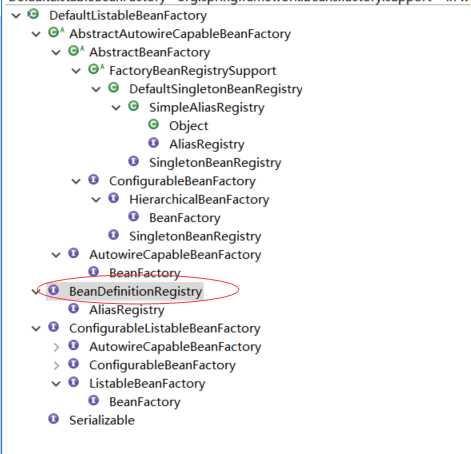
那麽我們就在registerBeanDefinition(String beanName, BeanDefinition beanDefinition)方法裏面打個斷點,然後debug運行前面的示例代碼到這裏:

這樣我們就能快速的拿到整個調用棧,而不用一步一步的去debug代碼了:

那麽怎麽來具體分析調用棧呢?
主要看調用棧(看從開始到註冊bean定義這件事情)用到了哪些類的哪些方法,看傳參。工作是如何分配、分工協作完成的。
看傳參重點是看輸入的參數(如xml配置文件的路徑)在這些類中是怎麽變化的(代碼的本質其實就是對輸入數據的各種處理得到最終想要的結果),從而知道每一個類是幹什麽用的。分析完整個調用棧以後,想要了解哪一部分就點擊對應的調用棧去分析就行了。
從調用棧可以看到要加載xml、解析xml獲取bean定義、註冊bean定義到bean工廠這些事由以下4個部分組成:

說明:
方法裏面含有<init>的表示是在構造函數進行初始化,方法裏面帶有(AbstractApplicationContext).refresh()的表示調用的是AbstractApplicationContext父類的refresh()方法,其他的類似
從方法和參數上我們可以看出這4部分分別是做什麽:
第一部分:初始化IOC容器,創建了內部的BeanFactory,然後將加載xml的工作委托給了XmlBeanDefinitionReader。
第二部分:XmlBeanDefinitionReader完成了對輸入數據:字符串——>Resource——>EncodedResource——>InputSource——>Document的轉變。
第三部分:DefaultBeanDefinitionDocumentReader完成對Document中元素的解析,獲得Bean定義等信息。
第四部分:就是簡單的完成bean定義的註冊。
接下來,你就可以針對每一部分去看你感興趣的處理邏輯、數據結構了。
比如:你可能對第三部分Document中元素的解析很感興趣,想搞清楚它是如何解析xml文檔中的各種標簽元素的。
1.1.1 xml元素的解析
從第三部分的調用棧上,我們可以看到如下變化:

1——>2 :Document ——>Element

看 doRegisterBeanDefinitions 方法:



接下來看在 parseBeanDefinitions 方法中是如何來處理裏面<beans>的元素的:
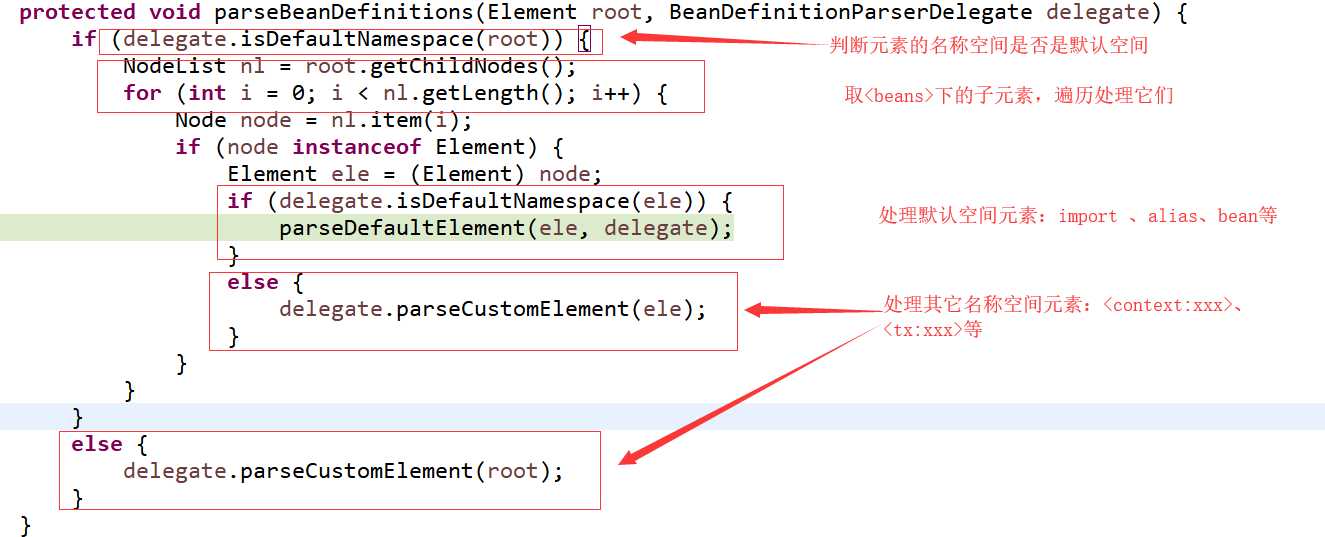
至於它是如何解析bean的不重要,很簡單的。我們重點關心的是它是如何處理其他名稱空間元素的,因為這裏是個變化點:其他模塊所需要的標簽各異,表示的信息也不同,它也不知道其他模塊會有哪些標簽。
它是如何做到以不變應萬變的?看下面的xml配置示例:
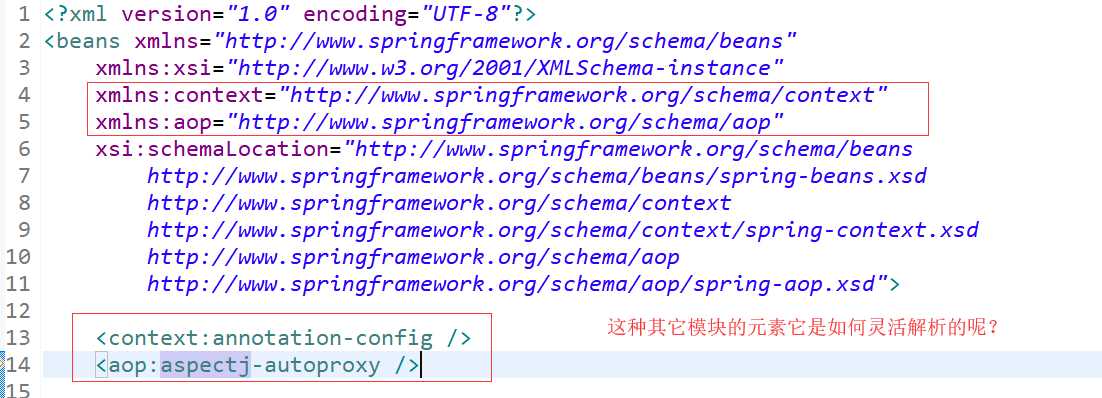
就來看 parseCustomElement方法:

先來看一下 NamespaceHandler 的繼承體系:
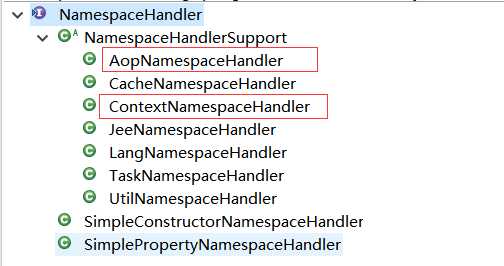
NamespaceHandler 裏面定義的方法:

請詳細看NamespaceHandler的接口註釋,方法註釋說明了方法的用法。
問題:名稱空間對應的處理器在不同的模塊實現,這裏是如何加載到的?如事務處理的根本就不在現在的這裏。那就要去看圖中的這條語句的方法調用了:

進入resolve 方法

它是一個接口,那這裏用的是它的什麽實現類對象呢?


我們看到有兩個屬性classLoader,handlerMappingsLocation。從handlerMappingsLocation這個名字能知道這是處理器與名稱空間的映射的配置所在的地址。從前兩個構造方法,我們看到它給入了一個常量的地址值:

可大膽推測它是要到類目錄下去找這個文件。看下我們的 spring 的模塊 jar 包下有沒有這個文件


接下來來看下 resolve 方法:


請把NamespaceHandler、NamespaceHandlerResolver的類圖畫出來。思考一下這裏有用到什麽設計原則、設計模式?【很重要】
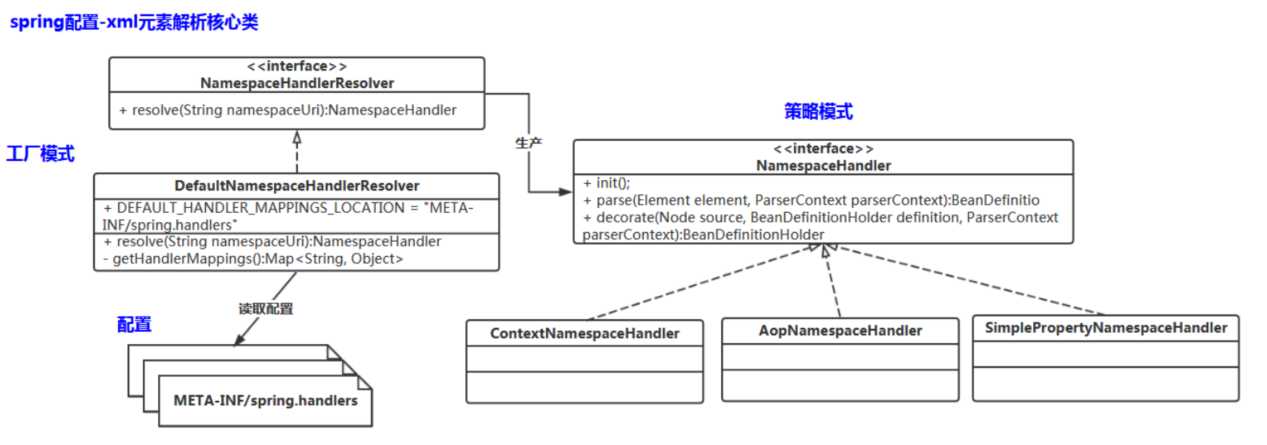
擴展:
1)如果你需要加一個自己開發的模塊(含自定義的bean定義標簽)到spring中,你是否可以做到了。
請看我的文章:
dubbo系列三:dubbo源碼分析(dubbo框架是如何跟spring進行整合的,消費者獲取的代理實例是如何創建的呢、生產者怎麽把內容註冊到註冊中心的,然後消費者是如何獲取這個信息的、dubbo負載均衡策略)
中的dubbo框架是如何跟spring進行整合的
2)spring標簽處理這裏的設計:模塊之間可以靈活組合,配置在各自的模塊中,即插即用。你是否可以把它應用到你的系統設計上。
策略模式跟工廠模式的組合使用
那麽通用的實現 GenericXmlApplicationContext 加載xml、獲取bean定義、註冊bean定義的調用棧是否也是一樣的呢?
ClassPathXmlApplicationContext加載xml、獲取bean定義、註冊bean定義:
//類路徑下加載xml配置文件創建bean定義 ApplicationContext context1 = new ClassPathXmlApplicationContext("application.xml");
斷點在DefaultListableBeanFactory中的註冊方法上:

GenericXmlApplicationContext 加載xml、獲取bean定義、註冊bean定義:
//通用的xml方式加載xml配置文件創建bean定義 ApplicationContext context3 = new GenericXmlApplicationContext("file:e:/study/application.xml");
斷點還是在DefaultListableBeanFactory中的註冊方法上:
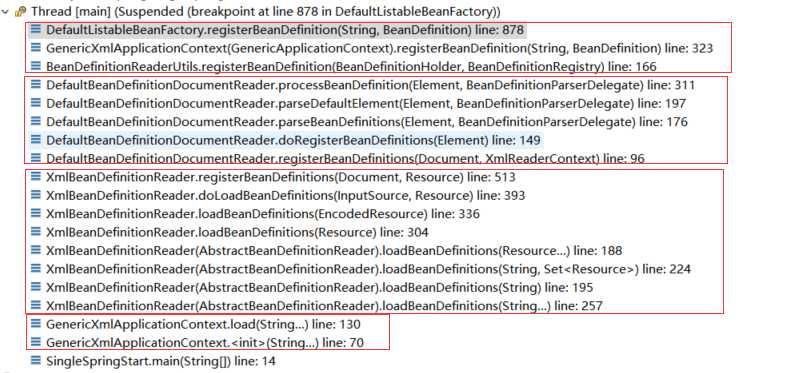
經過對比:
ClassPathXmlApplicationContext和GenericXmlApplicationContext 加載xml、獲取bean定義、註冊bean定義的過程是一樣的
1.2 bean工廠DefaultListableBeanFactory
經過前面的分析,我們發現bean定義都是註冊到DefaultListableBeanFactory中。接下來就來認識一下它
在ApplicationContext的兩類實現中,通過查看繼承體系我們都可以看到ApplicationContext中持有DefaultListableBeanFactory:
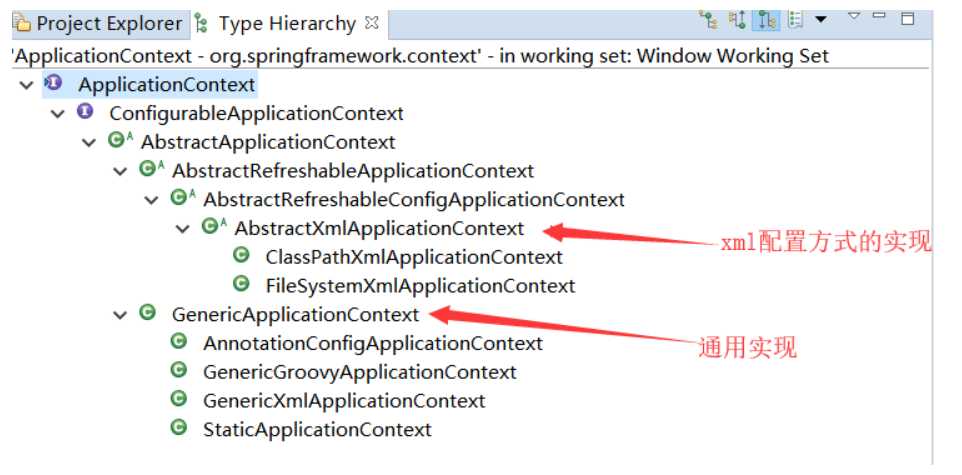
xml配置方式的實現的父類:

通用實現:

下面我們來看一下ApplicationContext和BeaFatory的關系
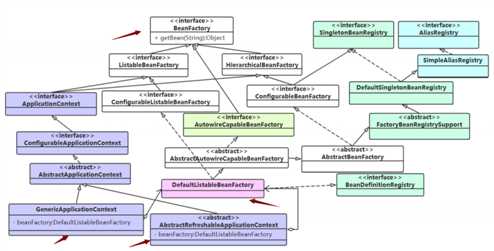
1.3 註解方式的bean配置的加載和解析
入口:
// 掃描註解的方式創建bean定義 AnnotationConfigApplicationContext context4 = new AnnotationConfigApplicationContext("com.study.leesmall.spring.service");
斷點還是在DefaultListableBeanFactory中的註冊方法上:

debug到上面的斷點以後拿到的調用棧:

在這個調用棧中,我們並發沒有看到它做包掃描的相關工作。從下往上看這個執行棧,點第2個執行棧看代碼:

它現在是在做一些初始化的準備處理,從這裏我們獲知,它做了registerAnnotationConfigProcessors。從名字上理解就是註冊了一些註解配置的處理器。到底是一些什麽processors,點方法進去看看:


註冊各種processor
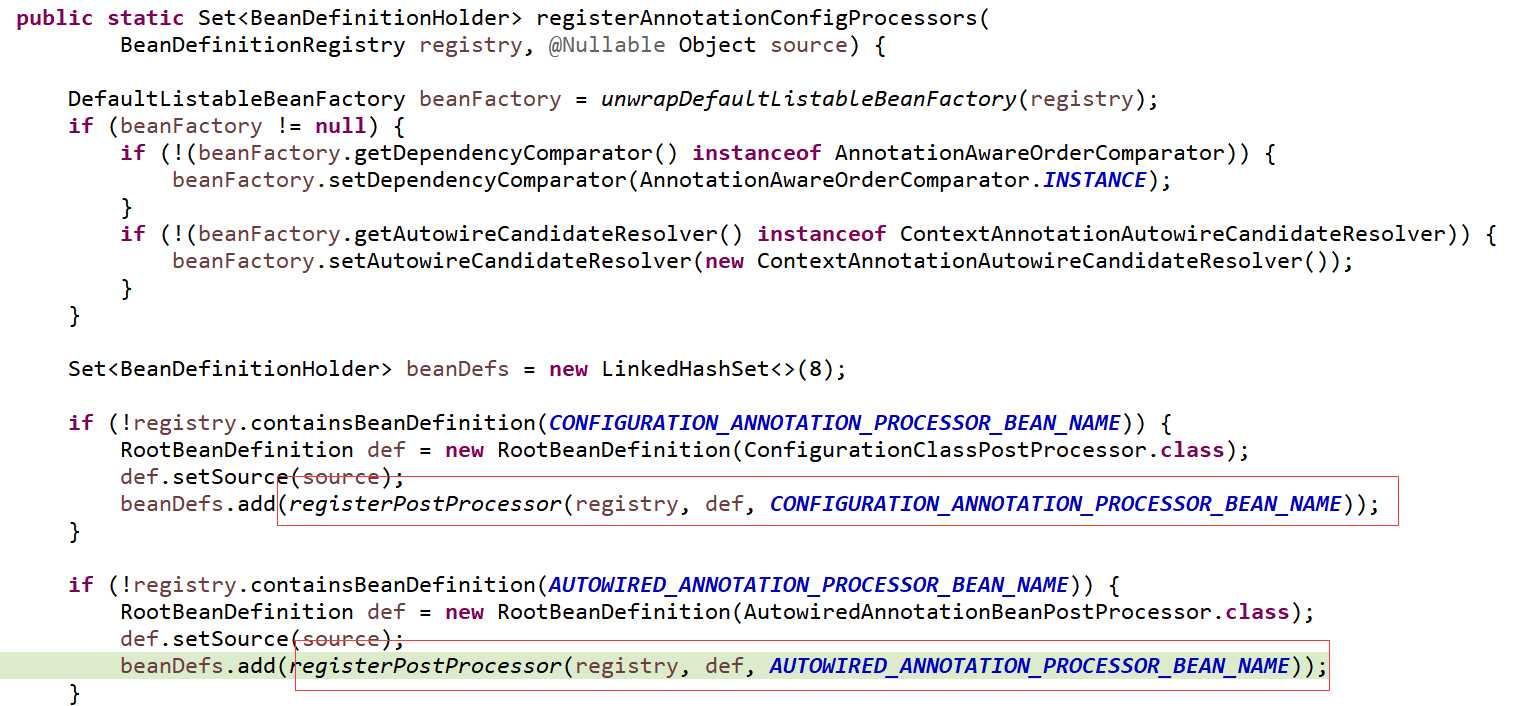

它註冊了很多的processor,都是些什麽Processor?點第一個的類名進去看看
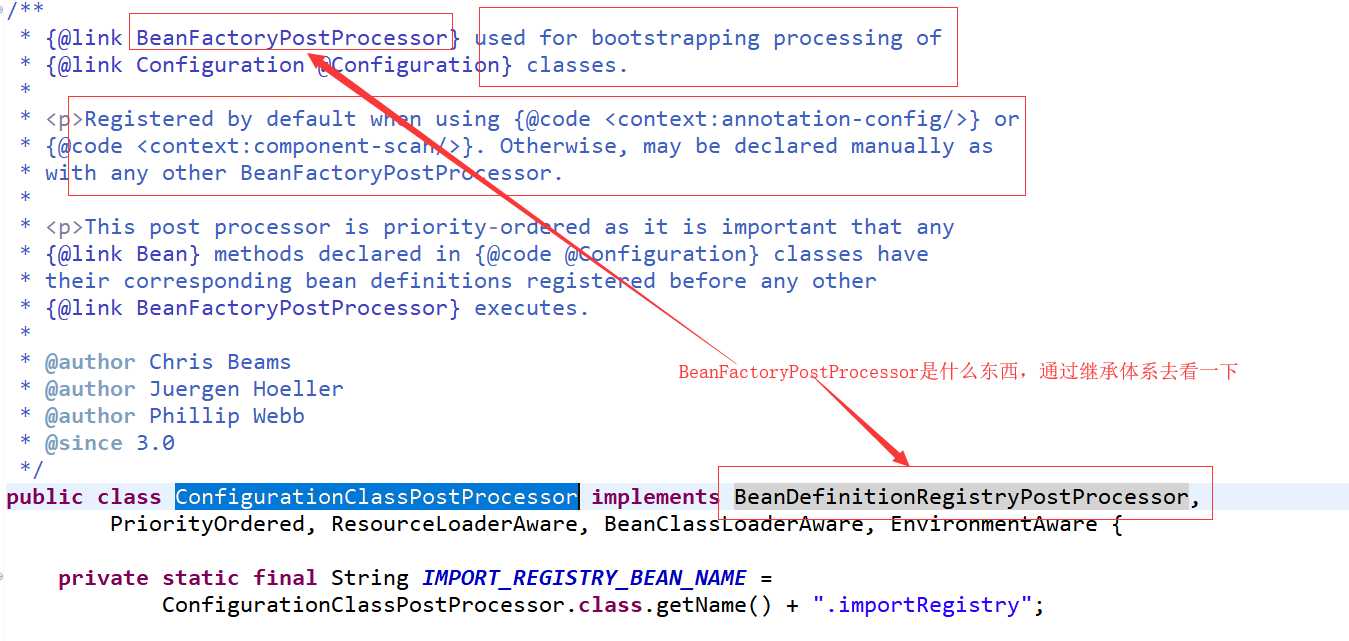

BeanDefinitionRegistryPostProcessor擴展了BeanFactoryPostProcessor,增加了BeanDefinitionRegistry位置的處理,即它可以提前對註冊好的BeanDefinitionRegistry進行前置處理。
下面我們來看一下BeanFactoryPostProcessor:
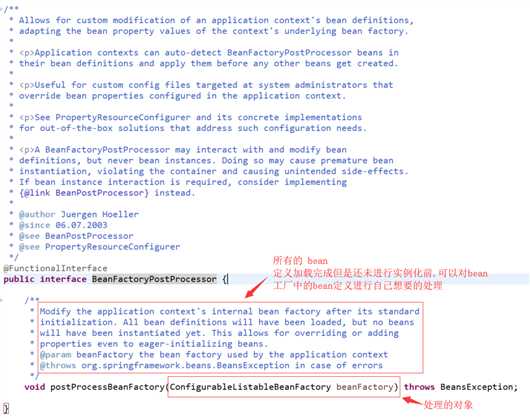
來看看BeanFactoryPostProcessor有哪些實現:
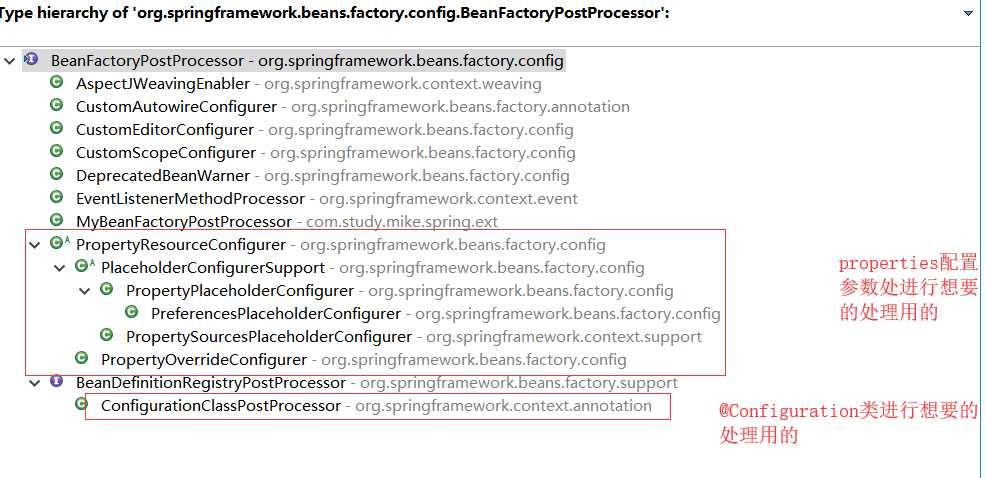
這是springIOC中給我們提供的又一個【擴展點】,讓我們可以在beanFactory開始創建Bean實例前對beanFactory進行一些處理!!!
使用示例如下:
<bean class="org.springframework.beans.factory.config.PropertyPlaceholderConfigurer"> <property name="locations" value="classpath:application.properties"/> </bean>
擴展一個自己的BeanFactoryPostProcessor:
package com.study.leesamll.spring.ext; import org.springframework.beans.BeansException; import org.springframework.beans.factory.config.BeanFactoryPostProcessor; import org.springframework.beans.factory.config.ConfigurableListableBeanFactory; import org.springframework.stereotype.Component; @Component public class MyBeanFactoryPostProcessor implements BeanFactoryPostProcessor { @Override public void postProcessBeanFactory(ConfigurableListableBeanFactory beanFactory) throws BeansException { System.out.println(this + " 擴展一個自己的BeanFactoryPostProcessor"); } }
入口:
// 掃描註解的方式創建bean定義 AnnotationConfigApplicationContext context4 = new AnnotationConfigApplicationContext("com.study.mike.spring.service"); context4.close();
BeanFactoryPostProcessor的類圖
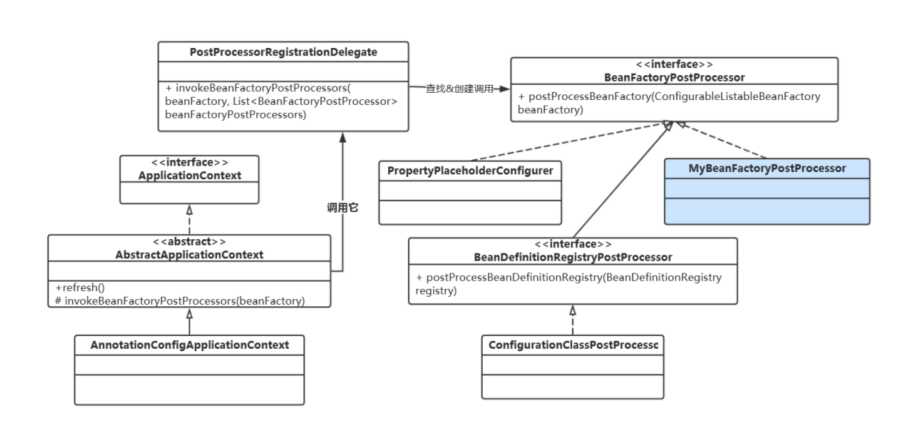
1.3.1 掃描包獲取bean定義的過程是怎樣的?
前面我們分析到,註解方式是在scan方法開始進行掃描的

那麽我們就在這個方法的這裏再打個斷點,記住之前的bean工廠註冊方法裏面的斷點保留,debug調試看一下調用棧

從調用棧上我們可看到有哪些類參與進來,在哪裏發生的什麽。
下面來看一下是怎麽掃描的:


下面來看一下掃描候選組件的方法:

類圖如下:
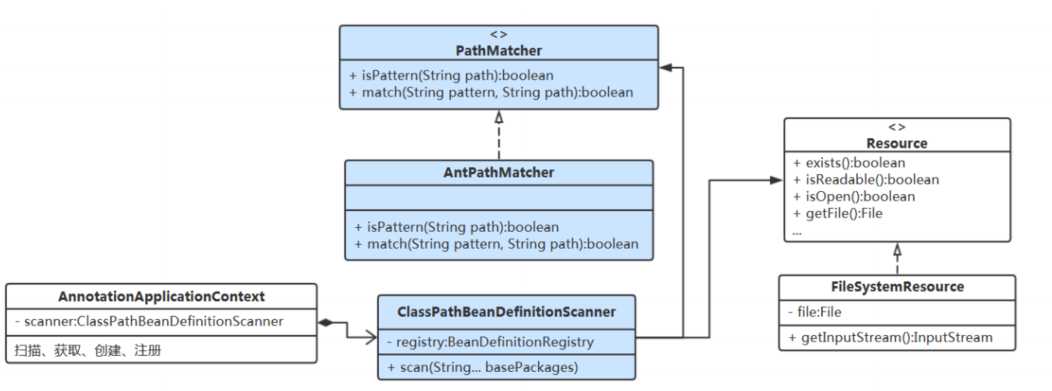
參考文章:
Spring Java-based容器配置
完整代碼獲取地址:https://github.com/leeSmall/FrameSourceCodeStudy/tree/master/spring-source-study
框架源碼系列六:Spring源碼學習之Spring IOC源碼學習

